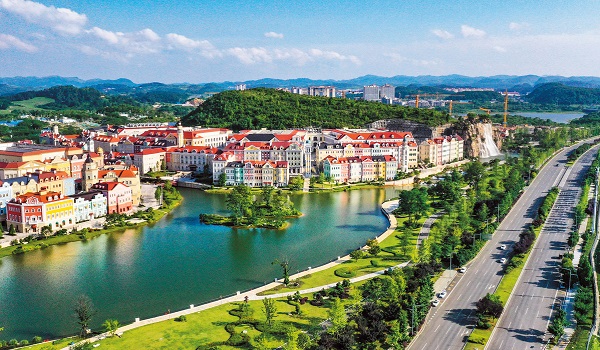Three years of transformation: Gui'an sees rapid socioeconomic development

A view of the data center built by Huawei Cloud in Gui'an New Area. [Photo/CHINA DAILY]
Gui'an New Area, approved by the State Council on Jan 6, 2014, is China's eighth national-level new area. On June 17, 2023, it set a goal of achieving visible annual progress and transformative changes within three years, and has since achieved remarkable outcomes.
Economic expansion
GDP growth in directly administered areas exceeded 20 percent for seven consecutive quarters since the third quarter of 2023, ranking among the top national new areas.
GDP in 2024 surpassed 40 billion yuan ($5.57 billion), with a resident population of 458,000, 28,000 market entities, and 42,000 new jobs created.
Industrial clusters
Gui'an developed three major clusters for the digital economy, new-energy power batteries and materials, and advanced equipment manufacturing.
It hosts 26 large-scale data centers with computing power exceeding 81 EFlops, where AI computing accounts for over 98 percent, making it a national leader in domestic computing resources.
Its industrial added value and industrial GDP share both doubled by 2024, compared to 2022 levels.
Open economy
Gui'an's foreign trade grew annually by 30 percent, while utilized foreign investment surged 56.7 percent per year.
Green development
The area has implemented green initiatives in production, consumption, lifestyle, and culture, with the green economy contributing 50.3 percent to the GDP.
Its sponge city coverage reached 70.6 percent of urban areas, urban wastewater collection hit 85.4 percent, and rural wastewater treatment achieved 71.4 percent.
Livability improvements
Gui'an's urbanization rate in directly administered areas reached 80.5 percent.
The area added 8,310 admission places through partnerships with elite institutions, such as Shanghai Normal University and Guiyang No 1 High School.
The First Affiliated Hospital of Sun Yat-sen University (Guizhou) was accredited as a tertiary A-grade hospital and a national regional medical center.
Rail Transit Line S1 commenced operations, enhancing public transport and boosting people's sense of fulfillment, happiness, and security.







 Overview
Overview
 Guiyang
Guiyang
 Guian New Area
Guian New Area
 Liupanshui
Liupanshui
 Anshun
Anshun
 Qianxinan
Qianxinan
 Qiandongnan
Qiandongnan
 Qiannan
Qiannan
 Zunyi
Zunyi
 Tongren
Tongren
 Bijie
Bijie
 Guizhou commits to culture preservation and rural vitalization
Guizhou commits to culture preservation and rural vitalization
 Guizhou voice at 2025 national two sessions
Guizhou voice at 2025 national two sessions
 Meet the 'genius moms' at Shenzhen cultural fair
Meet the 'genius moms' at Shenzhen cultural fair


